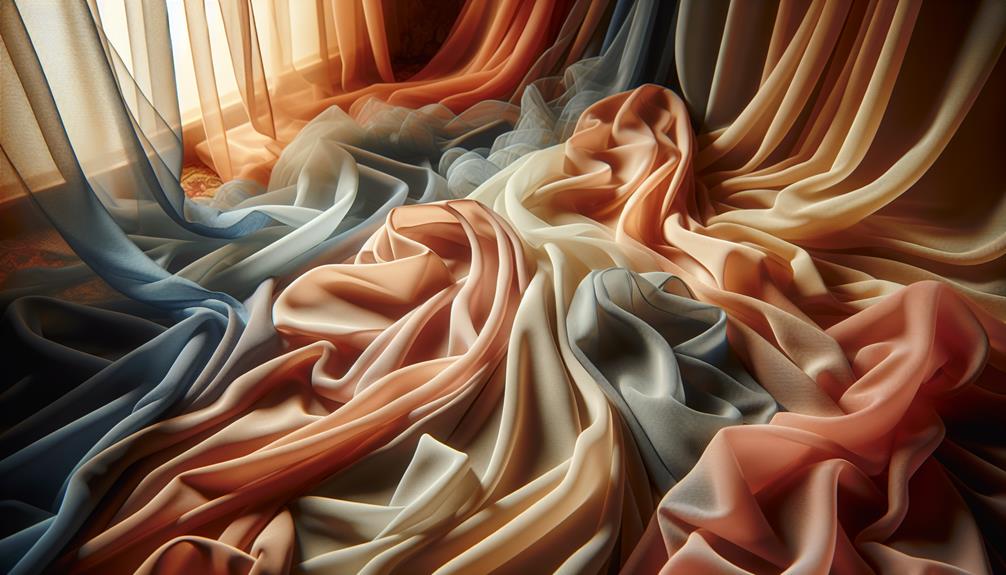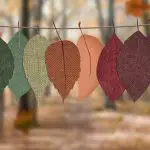Yes, there are different types of chiffon fabric! Silk chiffon is known for its elegant drape and vibrant color absorption, making it perfect for luxurious garments. Polyester chiffon is super versatile and easy to care for, so it's great for everyday wear. Nylon chiffon is durable and tear-resistant, ideal for flowy dresses and scarves. There are also blended chiffons that mix materials to offer both durability and elasticity, making them cost-effective and suitable for a range of styles. Each type has its own set of characteristics, so there's a lot more to uncover about how they can enhance your projects.
Table of Contents
Key Takeaways
- Silk chiffon is known for its elegant drape and breathability, ideal for vibrant, luxurious garments.
- Polyester chiffon offers versatility and ease of care, being machine washable and wrinkle-resistant.
- Nylon chiffon is characterized by its lightweight durability and resistance to shrinking and wrinkling.
- Blended chiffon fabrics combine synthetic fibers for enhanced durability and elasticity, suitable for diverse designs.
- Each type of chiffon has distinct care requirements, affecting the choice for different fashion projects.
Origins and Characteristics of Chiffon
Chiffon, known for its light, airy texture, originated from the French word for 'cloth.' It's been around since the 1700s, initially woven from silk by French artisans. The uniqueness of chiffon lies in its manufacturing process. The yarns are twisted, which causes slight puckering in various directions. This gives chiffon that slightly rough feel and a beautiful, sheer appearance.
I've discovered that chiffon isn't just one type of fabric. It's made from silk, cotton, synthetic fibers like nylon, or polyester. Each material brings different qualities to the fabric. For instance, polyester chiffon is highly durable and less prone to wrinkling compared to silk chiffon, making it a popular choice for everyday wear.
Handling chiffon can be tricky due to its delicate nature. Cutting and sewing with chiffon requires sharp scissors and a lot of patience. It's also a dream for dyeing, as it takes up colors well, producing vibrant, rich hues.
Silk Chiffon: Elegance Defined
Now, let's talk about silk chiffon, which really sets the bar for elegance in fabrics.
We'll explore its unique properties and see why it's such a popular choice for crafting fine garments.
It's all about the delicate balance of softness and durability that makes silk chiffon stand out.
Silk Chiffon Properties
Delicately woven from silk, chiffon offers an unmatched elegance and graceful drape that defines luxury in fabric. Its sheer texture and slight shimmer make it a favorite for high-end fashion. I've noticed that silk chiffon's unique properties stem from its fine threads and tight weave, which contribute to its soft, fluid feel. It's incredibly lightweight yet durable, which surprises many given its delicate appearance.
Silk chiffon also has fantastic dye-absorbing qualities, allowing for vibrant, rich colors that don't fade easily. This aspect is crucial for maintaining the luxurious appeal of garments over time. Plus, it breathes well, making it comfortable for wear in warmer climates or during balmy summer evenings.
Crafting With Silk Chiffon
Crafting with silk chiffon transforms simple projects into works of elegant artistry. Here's how you can master this delicate fabric:
- Choose the Right Tools: Use sharp, fine-pointed scissors for cutting and lightweight needles for sewing to prevent snagging the delicate fibers.
- Seam and Edge Finishes: Opt for French seams or rolled hems to give your projects a clean, professional finish.
- Stabilizing Fabric: Temporarily stabilize silk chiffon with spray starch or tissue paper during cutting and sewing to manage its fluid nature.
- Practice Draping: Take advantage of silk chiffon's graceful drape by practicing on mannequins before final stitching, ensuring your design aligns perfectly with the fabric's flow.
Master these techniques, and you'll elevate your chiffon creations from simple to sublime.
Polyester Chiffon: Versatile and Affordable
Polyester chiffon is a popular choice because it's both versatile and affordable. I find it's an excellent material for those of us who love the elegance of chiffon but need something a bit more forgiving in terms of budget and care. Unlike silk chiffon, which can be a nightmare to maintain, polyester chiffon is much easier to handle. It's machine washable, which saves a lot on dry cleaning bills.
This type of chiffon has a slightly heavier drape compared to its silk counterpart, making it ideal for dresses and skirts that require a bit of structure without losing flowiness. It's also great for crafting blouses that need to withstand regular wear. The fabric's resilience to wrinkles is another plus, especially when I'm traveling or on the go.
Price-wise, polyester chiffon is a winner. It allows me to experiment with various designs without worrying too much about cost. This is crucial when I'm trying out new patterns or dabbling in larger projects. So, if you're diving into the world of chiffon for the first time or simply looking for a practical option, polyester chiffon is worth considering. It really does offer the best of both worlds.
Nylon Chiffon: Lightweight and Durable
Now let's talk about nylon chiffon.
I'll cover its key properties, how you should take care of it, and what it's commonly used for.
It's known for being both light and tough, which makes it super versatile.
Nylon Chiffon Properties
Nylon chiffon's standout features are its lightweight nature and impressive durability. It's a go-to fabric for many because it combines the elegance of traditional chiffon with the perks of nylon. Here's a breakdown of why it's so awesome:
- Strength: Nylon fibers are incredibly strong. They resist tearing and snagging, which means your nylon chiffon outfits can handle a bit more rough and tumble.
- Weight: It's super light, making it perfect for flowy dresses and delicate scarves that won't weigh you down.
- Maintenance: Nylon is less prone to shrinking and wrinkling compared to natural fibers. This makes it easier to handle from a maintenance point of view.
- Versatility: Great for both evening wear and casual attire, it adapts easily to different fashion needs.
Care Instructions
To keep your nylon chiffon looking great, follow these simple care tips. First off, always check the care label. Sounds obvious, but it's easy to forget. Nylon chiffon is generally machine washable, which makes it pretty convenient. Use cold water and set your machine on a gentle cycle. I recommend using a mild detergent. Harsh chemicals can be brutal on the fabric's texture and color.
After washing, don't wring it out; that can lead to wrinkles and damage. Instead, lay it flat or hang it to dry. Ironing? Set your iron to a low heat, and if possible, use a pressing cloth to avoid direct contact with the fabric. It's all about keeping it cool and gentle to maintain its durability and sheen.
Common Uses
Lightweight and durable, nylon chiffon is often used for making flowing dresses and scarves. It's a favorite among designers and DIY enthusiasts for a few solid reasons. Here, I'll break down what makes nylon chiffon so versatile and appealing in the world of fashion and beyond.
- Wedding Gowns: Its airy quality adds a dreamy look to bridal wear without adding weight.
- Evening Wear: Perfect for those elegant, floaty evening dresses that require a bit of a drape.
- Lingerie: Used in lingerie for its soft texture and slight sheerness, adding an element of allure.
- Home Décor: Great for sheer curtains that need to let just enough light in while providing privacy.
This fabric really covers a lot of ground!
Rayon Chiffon: Soft and Absorbent
Rayon chiffon is known for its soft texture and absorbent qualities, making it a popular choice for flowy, breathable garments. It's like the go-to fabric when you want something lightweight but not too sheer. The thing about rayon chiffon is that it combines the elegant drape of silk chiffon with a more practical edge. It's easier to handle and maintain, which I find super handy.
Rayon, derived from natural cellulose, is processed into a silky material. This process results in a fabric that not only feels great but also has a good moisture absorption capacity. This makes rayon chiffon an excellent option for summer wear or humid climates, where comfort and coolness are priorities. It's breathable, which means it doesn't trap heat, and that's a big plus in my book.
I've noticed that rayon chiffon dyes beautifully. The colors come out vibrant and rich, which adds to its appeal for designers looking to make a statement with their collections. Moreover, the fabric has a slight sheen that catches the light, enhancing its aesthetic appeal without being too flashy. It's a versatile fabric that can be used in various garment styles, from elegant dresses to casual tops.
Blended Chiffon Fabrics: The Best of Both
Blended chiffon fabrics combine the best features of multiple materials, creating versatile and durable textiles ideal for various fashion needs. When I'm looking for fabric that'll stand up to diverse styling and wear, I lean towards these hybrids. They're a genius innovation in the textile industry, marrying the lightweight and elegant drape of traditional chiffon with the strength and flexibility of other fibers. This blend not only enhances the fabric's usability but also expands its appeal across different fashion genres.
Here's why you might want to consider blended chiffon for your next project:
- Enhanced Durability: The addition of synthetic fibers like polyester or nylon significantly boosts the strength and longevity of chiffon, reducing tears and wear over time.
- Improved Elasticity: Blends often include materials that offer better stretch, making the fabric more forgiving and comfortable to wear.
- Versatile Design Options: With blended chiffon, designers aren't limited to traditional looks. The fabric can handle a variety of dyes and treatments, broadening design possibilities.
- Cost-Effectiveness: Blending expensive natural fibers with more affordable synthetics can lower the overall cost, making high-end looks more accessible.
Caring for Different Chiffon Types
To keep your chiffon looking its best, it's crucial to understand the specific care each type requires. Whether you're dealing with silk, polyester, or a blend, each demands a unique approach. Let's break it down.
Silk chiffon is the most delicate. I always recommend dry cleaning to avoid any mishaps like shrinking or color bleeding. If you're daring and opt to hand wash, do so gently with a mild detergent and cold water. Never wring out silk chiffon; just lay it flat to dry.
Polyester chiffon is more forgiving. It's machine washable which makes life easier. Use a gentle cycle with cold water and a mild detergent. Like silk, avoid wringing it out. Instead, I gently roll it in a towel to remove excess water before laying it flat to dry. This method helps maintain its shape and texture.
Blended chiffon fabrics, mixing fibers like cotton or rayon with polyester, often combine care instructions. Stick to the most delicate fabric's care regime. Typically, this means leaning towards hand washing. Again, use cold water and a gentle touch.
Choosing the Right Chiffon for Your Project
Selecting the right chiffon for your project hinges on understanding each type's unique properties and how they align with your creative vision. Whether you're crafting a flowy evening gown or lightweight scarves, the choice of chiffon can make or break your design. Here's how I approach it:
- Assess the Drapability: Silk chiffon is unbeatable for delicate, graceful drapes. It's perfect when you want your project to have a soft, elegant flow. On the other hand, synthetic chiffons like polyester are more resilient and hold shape well for sharper, more structured designs.
- Consider the Sheerness: Think about the level of transparency you need. Silk chiffon offers a lovely, subtle sheerness, ideal for layers without adding bulk. Polyester chiffon is often slightly more opaque, which can be useful if you're looking for less transparency.
- Check the Weight: The weight of the chiffon affects how it moves and feels. Lighter chiffon is fantastic for breezy, airy designs, while heavier chiffon might be better for a more defined shape.
- Understand the Care Needs: Silk chiffon requires gentle handling and dry cleaning, whereas polyester chiffon is generally more forgiving and can often withstand machine washing. Choose based on your readiness to maintain the fabric.
Creative Uses of Chiffon in Design
Chiffon's versatility shines in design, where it's used to add elegance and movement to everything from bridal gowns to artistic installations. As a designer, I've found that its lightweight and semi-transparent qualities make it an excellent choice for layering effects in high-fashion pieces. It drapes beautifully, creating soft, flowing lines that can't be achieved with heavier fabrics.
In bridal wear, chiffon adds a dreamy, ethereal look to veils and trains. It's perfect for creating volume without adding weight, making it ideal for layered skirts that float as the bride moves. But chiffon isn't just for weddings. I've used it in scarves and wraps, which are great for adding a touch of luxury to everyday outfits. Its lightness makes it comfortable to wear, even in warmer weather.
On the artistic side, I've incorporated chiffon into installations where light plays a crucial part. The fabric catches and diffuses light in such a captivating way, adding depth and dimension to the art piece. Whether it's a backdrop for a photo shoot or part of a larger art installation, chiffon can transform a simple space into something magical. Its uses in design are only limited by your imagination.
Frequently Asked Questions
Can Chiffon Fabric Be Dyed at Home?
Yes, I can dye chiffon fabric at home using acid or reactive dyes, depending on the fiber content. It's important to carefully follow specific dyeing instructions to achieve evenly distributed, vibrant colors.
Is Chiffon Suitable for Winter Wear?
Sure, I'll wear chiffon in winter—if I want to freeze! Honestly, chiffon's lightweight and airy nature makes it better suited for warmer weather, not the chilly blasts of winter months.
How Does Chiffon Impact the Environment?
I've learned that chiffon's environmental impact varies by its material. Synthetic chiffon, made from non-biodegradable plastics, contributes to pollution, while natural silk chiffon is more sustainable but still raises concerns about resource consumption.
Are There Fire-Resistant Types of Chiffon?
Yes, there are fire-resistant chiffon options. They're typically treated with chemicals to enhance their resistance to flames. It's great for safety in environments where you might be exposed to heat or sparks.
Can Chiffon Be Used for Upholstery Purposes?
I've discovered that while chiffon can be used for upholstery, it's not ideal because it's quite delicate and lacks the durability needed for frequent use. Heavier fabrics are usually better choices for upholstery.
- What Is Chiffon Best Used For? - April 23, 2024
- Is Chiffon Fabric Itchy? - April 23, 2024
- Are There Different Types of Chiffon Fabric? - April 23, 2024








